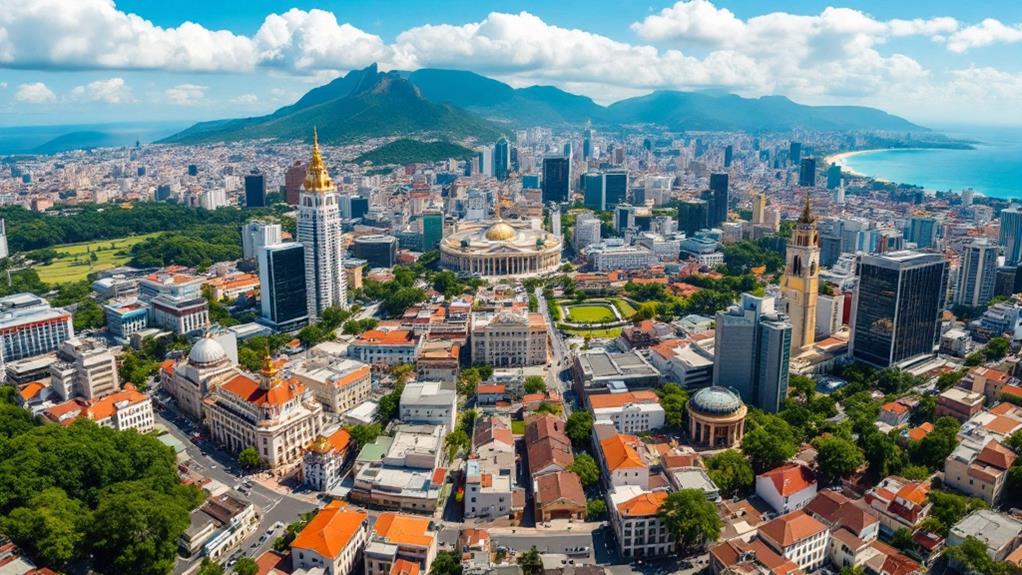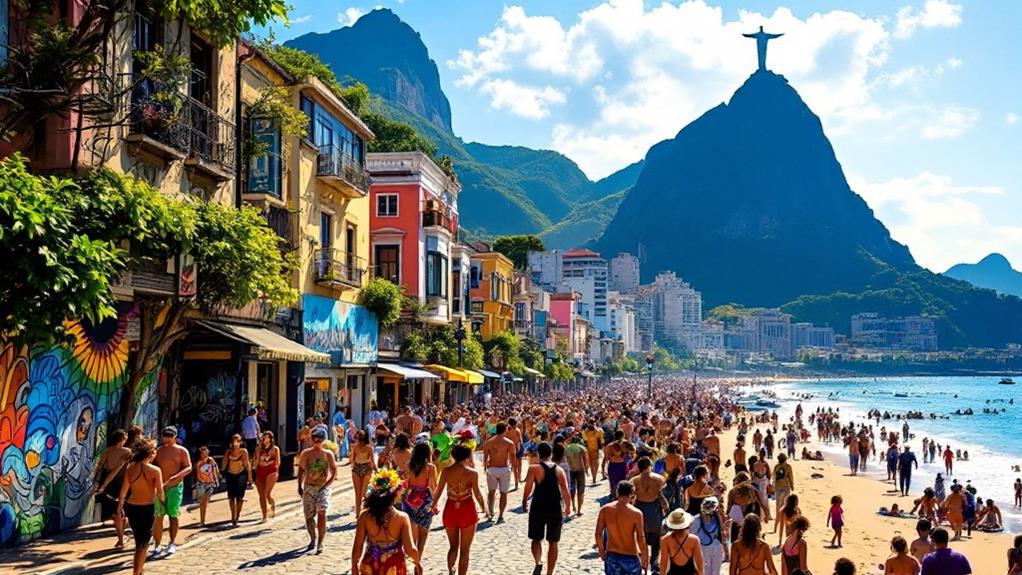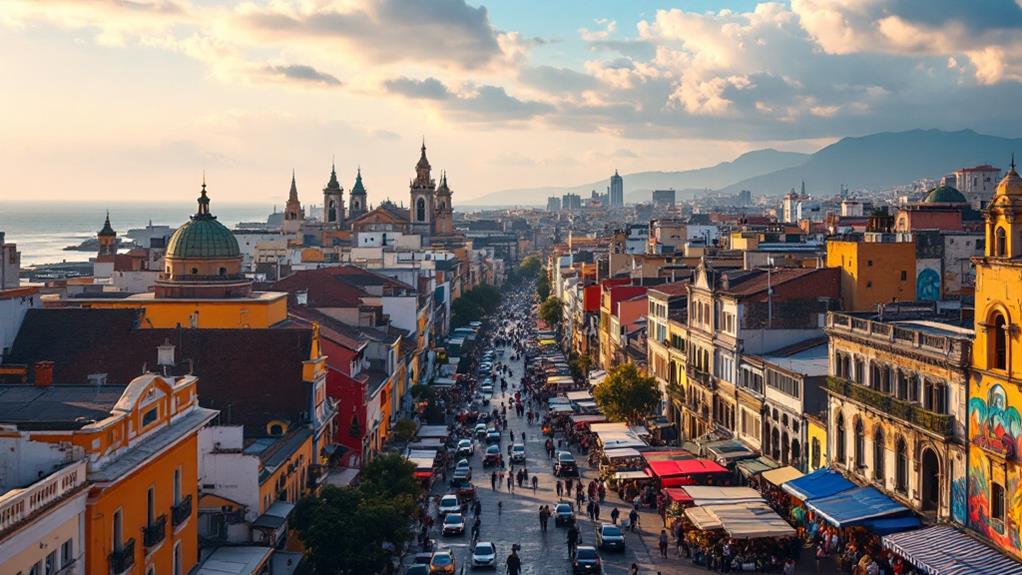The Largest Cities in South America: What Makes Them Stand Out?

South America's largest cities like São Paulo, Buenos Aires, and Rio de Janeiro offer lively experiences and compelling reasons to visit. São Paulo, with its sprawling population, is Brazil's financial nerve center and a cultural hub. Buenos Aires enchants with its historical depth, tango rhythms, and diverse architecture. Rio de Janeiro mesmerizes with its dynamic energy, world-famous Carnival, and stunning landmarks like Christ the Redeemer. Bogotá drives Colombia's economy, while Lima fascinates with its culinary scene and gateway to Machu Picchu. Santiago beautifully blends modernity with natural allure. Uncover more about what makes each city distinctively enthralling.
Cultural Highlights of São Paulo
São Paulo, Brazil's largest city, is a spirited cultural hub that showcases a fascinating blend of art, music, and cuisine, thanks to its diverse immigrant communities. You'll find that this cultural melting pot seamlessly mixes global influences with local traditions, creating a lively arts scene. The São Paulo Museum of Art stands as an indication of the city's commitment to art, housing an impressive collection of Western masterpieces by artists like Van Gogh, Rembrandt, and Picasso. Its modernist architecture alone is worth the visit.
Music and performance thrive here, with numerous cultural institutions such as theaters and the São Paulo Symphony Orchestra enhancing the city's rich artistic tapestry. The annual Virada Cultural event transforms the city into a non-stop festival, celebrating music, dance, theater, and art. It's an experience you won't want to miss, drawing millions each year.
Fashion enthusiasts flock to São Paulo Fashion Week, Latin America's premier fashion event, which showcases cutting-edge trends and attracts international designers. As you investigate the city, the culinary scene won't disappoint, offering a delicious fusion of flavors that reflect the city's multicultural identity. São Paulo truly stands out as a dynamic cultural destination.
Historical Depth of Buenos Aires
While Sâo Paulo captivates with its lively culture, Buenos Aires enchants with its rich history. Founded in 1536 by Pedro de Mendoza, Buenos Aires faced early challenges, leading to temporary abandonment before its reestablishment in 1580. The city's name, translating to "Good Airs," reflects its coastal allure that initially attracted European settlers.
Throughout its history, Buenos Aires has been a melting pot of cultures, heavily influenced by immigration, especially from Spain and Italy. This diverse influx has left a lasting impact on its architecture and culture, earning it the nickname "Paris of South America." As you wander through its streets, you'll notice the European-style buildings that echo the grandeur of Paris, seamlessly blending with the city's lively lifestyle.
Buenos Aires wasn't just a backdrop for cultural fusion; it also played a crucial role in Argentina's quest for independence. The city was a hotbed for revolutionary activities in the early 19th century, marking its place in history as a cradle of freedom. Today, the spirit of independence is alive in its tango music and dance, which continue to captivate and define Buenos Aires' unique identity.
Vibrancy of Rio De Janeiro

Situated between lush mountains and the Atlantic Ocean, Rio de Janeiro dazzles with its stunning natural beauty and spirited cultural scene. As you navigate the city, you'll quickly notice its dynamic energy, fueled by its 13.8 million population and their zest for life. One of the most iconic events is the Carnival, a world-famous festival that attracts over 2 million visitors annually. It's a spectacle of samba rhythms, colorful parades, and elaborate costumes that truly captures the city's spirit.
In Rio, iconic landmarks like the Christ the Redeemer statue stand tall, offering breathtaking panoramic views from atop Corcovado Mountain. This monument, recognized as one of the New Seven Wonders of the World, is a must-see and perfectly complements the city's natural beauty. The stunning beaches, particularly Copacabana and Ipanema, are not just for sunbathing; they're hubs of cultural significance and recreational activities, embodying the city's spirited atmosphere.
Beyond the beaches, Rio's cultural scene thrives with numerous music festivals, art exhibitions, and museums. These venues celebrate the city's historical roots and contemporary flair, ensuring there's always something engaging to experience, making Rio de Janeiro a truly dynamic destination.
Economic Influence of Bogota
Bogotá stands as Colombia's economic powerhouse, boasting a population of approximately 11.6 million in 2024. Its economic influence is undeniable, with the city contributing notably to the nation's GDP. This is largely due to its diverse sectors, such as finance, trade, and manufacturing. With over 50% of Colombia's industrial output coming from Bogotá, you're looking at a crucial center of business and commerce.
The city's strategic location on the Andean plateau amplifies its role as a logistical hub. It facilitates trade and transport within Colombia and to neighboring countries, making it an integral player in regional trade. This strategic advantage is further intensified by Bogotá's investment in infrastructure and urban development. These efforts not only improve economic capacity but also attract national and international investments.
Innovation centers and tech companies are flourishing here, marking Bogotá as a rising star in the digital economy. The growing startup ecosystem reflects the city's adaptability and forward-thinking attitude. You can see how Bogotá's economic landscape is transforming, driven by its robust industrial output and strategic initiatives. It's a city that utilizes its strengths to maintain and expand its economic influence across the region.
Lima's Unique Blend

Bogotá's economic dynamism showcases the impact a city can have on a nation, and a similar liveliness can be seen in Lima, albeit with a unique cultural twist. Known as the "City of Kings," Lima overlooks the vast Pacific Ocean, offering a intriguing blend of colonial heritage and modern urbanization. Founded in 1535, this city is a tapestry of history and innovation, where historical architecture like stunning churches and monasteries stand alongside contemporary skyscrapers.
Lima's urban landscape is a reflection of its significant growth, with a population of approximately 11.3 million in 2024, making it the sixth-largest city in Latin America. This population boom reflects not just urban density, but also a flourishing cultural scene. As a celebrated global culinary destination, Lima's gastronomic offerings are rich and varied, weaving indigenous flavors with international influences.
Beyond its lively streets, Lima serves as the gateway to Machu Picchu. This connection to one of the world's most famous ancient Incan cities makes it a crucial starting point for those enthusiastic to investigate Peru's historical wonders. In Lima, every street corner reveals a story, blending past and present into a unique cultural experience.
Santiago's Modern Appeal
Santiago, Chile's energetic capital, combines urban dynamism with natural beauty, creating a city of striking contrasts. It stands out with its modern infrastructure and a well-developed public transport system. The extensive metro network makes getting around easy, ensuring that Santiago's lively streets remain accessible and efficient. As the capital of Chile, Santiago is not just the country's largest city but also a key economic hub in South America, home to about 6.9 million residents.
The Andes mountains frame Santiago, offering breathtaking views and making outdoor adventures like skiing and hiking easily accessible. This proximity to nature provides a unique balance between urban life and natural beauty. Santiago's cultural scene is rich and diverse, with attractions like the Museo Nacional de Bellas Artes and colorful neighborhoods such as Bellavista, where artistic expression and culinary delights abound.
Santiago's commitment to urban sustainability and innovation also sets it apart. Efforts in this area improve its reputation as a modern metropolis, focusing on environmentally friendly practices and forward-thinking urban development. In Santiago, you'll find a city that seamlessly blends modernity with tradition, all under the watchful gaze of the Andes.



